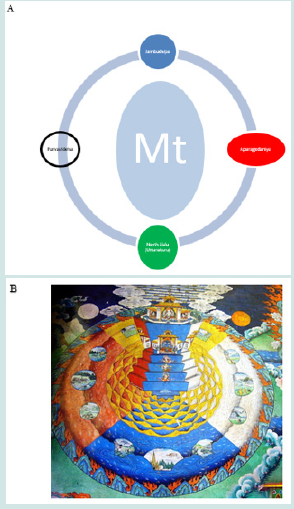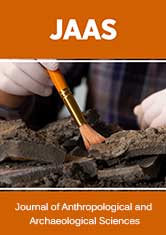
Lupine Publishers Group
Lupine Publishers
Menu
ISSN: 2690-5752
Research Article(ISSN: 2690-5752) 
The World Systems and Past Events According to The Analyses of Buddhism Literatures Volume 10 - Issue 2
Wanpeng Sun*
Independent Researcher, Newfoundland, Canada
Received: October 22, 2024; Published: October 29, 2024
Corresponding author: Wanpeng Sun, Independent Researcher, Newfoundland, Canada
DOI: 10.32474/JAAS.2024.10.000333
Abstract
There are different views about the world, the universe and past history. This article will focus on the theories according to the Buddhism literatures. There are three major approaches to study the ancient history of human civilization: 1. History-related Record; 2. On-site Discovery; 3. Supernatural Exploration. The supernatural exploration is usually only accessible to top elites, and often carried out secretly by higher officials, because most public civilians are not able to believe that. For example, CIA has explored the ancient Mars by a person who has supernatural abilities [1]. That person is able to visualize Mars and see what happened a million years ago. The project’s name is Mars Exploration, an exploration by supernatural abil-ity. The result is in line with the later-on scientific discovery that the Mars could have pre-historical civilization which was wiped out by N explosions [2,3]. In this case, the super-natural ability is used not only for study the ancient events but also for exploring the universe. Regarding supernatural abilities, there are different levels. Who have the most powerful su-pernatural powers? Apparently, the ancient religious leaders that built up a long-lasting reli-gion have the most powerful supernatural abilities than others. Thus, it is an innovative and resourceful approach to study the human civilization and even some earth events from the re-ligious books authored by ancient saints. Buddhism Sutra is the record for the teachings of Buddha, who told the stories according to his observation. There are a number of Buddha’s observations about pre-historical events as well as the world systems (universe) as document-ed in Buddhism sutra; such pre-historical events and world-component theories are believed to be true according to the exploration of Buddha through his supernatural ability. This article will study the past history and the world models via critical analyses of Buddhism literatures, especially these sutras.
Keywords: Mahayana Buddhism; Ganger River Sand; Shakyamuni Buddha; Amitabha; Bodhisattvas; Kalpa
Introduction
Pending on the texts in the Buddhism books, a world could refer to a very tiny one or a very large one, the latter of which is typically composed of billions of the tiny ones. If it is not specified, in Mahayana Buddhism literature, a world usually refers the realm where a Buddha preaches dharma, and often refers to the large world, which will be discussed in below texts. How about the tiny one? Well, it is still bigger than our earth. It refers to a world with the Mountain Sumeru (also called Mount Meru, a giant invisible object like dark matter), Sun, moons, four major planets and eight minor planets as well as over 80,000 smaller objects called islands [4,5].
Figure 1. This kind of world system is often called “4-underskies” system in Mahayana Buddhism literature. Originally, one “undersky” refers to a major planet like our earth. The reason that ancient Buddhism called an earth as “undersky” because the “sky” is an important concept for a livable planet. More details have been discussed in previous publication [4]. According to Buddha, a small-thousand world is composed of over 1000 of such world systems; it is noteworthy that a small-thousand world does not necessary to contain exactly 1000 “4-underskies”; it could be more, like 2000, 3000, etc. A medium-thousand world is composed of over 1000 (could be 2000, 3000…) of the small-thousand world; a large-thousand world is composed of over 1000 (2000, 3000…) of the medium-thousand world. This is where the common phrase of “three thousand realms” originally came from. The “three thousand realms” is more like a jargon, very popular in many eastern religions. Actually, this terminology should be corrected as the “thousand to the power of three” world, which is referring to a large-thousand world. One large-thousand world is the territory for one Buddha who is preaching his dharma. The compassionate Shakyamuni Buddha is not only delivering teaching in this earth, but also in the tens of billions of earths in the large-thousand world. Each world has a unique name. Our large-thousand world is called the Tolerable World (often translated as the Suopo World according to the pronunciation), where Shakyamuni Buddha preaches Buddhism. Thus, one large-thousand world is also called one Buddha Territory. In many sutras of Mahayana, the largest sect in Buddhism [6], one Buddha Territory is often called one Buddha World or “one World”. Hereby, one World is referring to a largethousand world, which contains tens of billions of human-habitat planets like our earth. It is noteworthy that it is reasonable to refer the large-thousand world as “a world” because it is actually very tiny comparing with other huge objects. Figure 1. Depending on the texts in Buddhism literatures, a “world” could refer to a very tiny one or a very large one. Even a tiny one is bigger than our earth. A) The world model for the “tiny one”. In some literature, it is called the Cakkavala. In Mahayana Buddhism, it is often called “4-underskies” (system). One “undersky” is referring to one major planet (like our earth) that surrounds the Mt. Meru. The central ellipse circle represents the Mount Sumeru (Meru). Surrounding it, there are four circles, representing four major earths (planets), each of which has their own names and different colors of skies and each of which has two minor planets nearby. There is “water” around each planets; the “water” here is more like the ether-like dark matter, which is discussed in previous publications [7-9]. Our planet is called Jambudvipa (translated as Yanfuti according to part of pronunciation in some literatures), or Jumbo Continent, located on the south side of Mt. Meru; its name has been explained in previous research [5,7]. In Hindu, Jain and Buddhist cosmology, Uttarakuru (often translat-ed as North Jiulu) is in the north side of Mt Meru. Its name means the unpleasant sounds. In North Jiulu, people can live for 1000 years old. They share everything including clothes and sex partners. A child is fed by the whole community. If a man and woman want sex, they will go under trees. If the tops of trees become separate and do not shade them, that means they are close relatives, and they should not mate. If the tops of trees look like closer and their shades can shade them, it means they are not close relatives and they can mate. The name of Uttarakuru means the north continent with unpleasant sounds. Over there, the people can live for one thousand years; however, there is a special sound that reminds them when their lives are closing to an end. The people in other two major planets can live for 200 and 300 years respectively. It is unclear if they are same species as Homo sapiens, because, in the sutra of Ahan Jing, it mentions the women in North Jiulu only have the pregnancy period for a week and then give birth, which is much shorter than modern human in our earth. People do busi-ness and exchange goods in other three major planets, except the North Jiulu where they share resources; over there the paper money is just paper and useless. B) Courtesy of Tibetan Buddhist Encyclopedia [10]. Tangka (Tibetan drawing) shows the eight smaller planets: there are two smaller planets around each abovementioned planets; all of them are human habitats. In the center of Tangka, it is the Mt Meru; there are god realms above the Mt Meru. In order to draw the god realms, this drawing has blocked one of the planets (the North Jiulu); therefore, only eleven habitats were drawn. It is noteworthy that this Tangka should be drawn after Age of (Eu-ropean’s) Exploration; not too far from today, because they drew north on top following European tradition; while, in ancient map, south is often on the top (as A). All of these twelve planets have their unique names; in addition to the 4 names shown in A, the names for the eight minors are called JuLapo, Lapo, Shedi, Shangyi, Tike, PiTike, Chamara and FaluoChamara. Once of smaller planet is called Chamara, where mainly live hu-manoid beings called Rakshasas [11]. According to a Tibetan legendary story, it is said the Rakshasas’ king was killed by the Guru Rinpoche Padmasambhava (“Born from a Lotus”), who processed the Rakshasas King’s body and commands Rakshasas to do good things. Note: the drawing is not according to the real scale; for ex-ample, the Mount Meru should be tremendously much larger.
As mentioned above, our World (referring to the large-thousand world) is known as the Tolerable (Suopo) World according to Buddhism literatures. “Suopo” is the translation according to the pronun-ciation; “tolerable” is the translation according to the meaning. It is worthy of mentioning that not only Shakyamuni Buddha called our world as the Tolerable World; other civilizations in other worlds also called our world as the Tolerable World, which is the major characteristic of our current world. Ac-cording to Buddha’s teachings, there are tens of billions of human-living earths in this world; thus, one world in Mahayana Buddhism could refer to a galaxy or even the universe. A world is big in current human’s scale; however, a world is still very tiny small under the whole picture of the universe. It is less than a drop of water comparing with an ocean of worlds. Our world is just one of worlds in the Flower- Treasure-Noble World Ocean. Out of this World Ocean, there are other World Oceans, such as the Pure-Light-Lotus-Noble World Ocean, the All-Treasure-Moon-Brightness-Noble World Ocean, the Colored-Glass-Lotus-Light-Completion-Treasure World Ocean, the Jumbo-Gold-Glass-Color-Umbrella World Ocean… [12]
In our Flower-Treasure-Noble World Ocean, there are numerous world clusters, which are called the world seeds. There is a world cluster called Shinning-All-Directions-Treasure-Brightness World Seed. Inside the Shinning-All-Directions-Treasure-Brightness World Seed, there are numerous other worlds in addition to our Suopo World. Some of them are purelands, some of them are dirty worlds, and some of them are mixed. Not all worlds are same. For example, the well-known Pureland of Amitabha Buddha has the formal name as the Extremely Happy World, where Amitabha is preaching Buddhism. Amitabha means a Buddha with unlimited life span, emitting unlimited light. There are no Mounts Meru and no Suns in Amitabha’s world, which is lighted up by the lights emitted by Amitabha and other objects in that world.
According to Huayan Sutra, one of the most influential sutras of Buddhism, there are numerous shapes of different worlds; there are also numerous worlds with same shapes. Some worlds have Buddha and some worlds do not have Buddha. Similar as watching flowers in a big garden: some flowers are in blossom, some are just starting, and some are shrinking; some worlds are coming into being, some worlds are in their stable stages, and some worlds are coming into the ends. Some worlds are always pure; some worlds are turning from dirty to pure when Buddha preaches his teaching and people learn to do good deeds; some worlds are turning from pure to dirty when Buddha enters Nirvana and people do bad deeds. Some worlds only exist for one Kalpa (cycle) and some worlds can exist for countless Kalpas. The world (Shijie) in Buddhism originally means the flowing of time within a boundary. Thus, the time in some worlds are significantly different from others. For example, one day in Amitabha’s World is equal to one Kalpa in our Suopo world. In another word, the length of one day in Amitabha’s pureland is very long, equal to the extremely long period that our world came into being, entered stable stage, diminished, entered an “empty” stage and reformed again.
Current human technologies and even future AIs cannot explore worlds in such an extremely huge scale. The Buddhism literature documented Buddhas’ and Bodhisattvas’ descriptions of different worlds according to their supernatural visions. A Bodhisattva is also called the Son of Buddha, referring to a person who is practice the merciful wishes as Buddha did and who will become Buddha in future. Bodhisattvas have different enlighten stages; their supernatural abilities have different levels. All Buddhas have the ability to know everything; thus, Buddha is also named as the correctly-all-know Buddha. Not all Bodhisattvas with supernatural abilities are able to observe the whole pictures of the World Oceans. In Huayan sutra, it documented that many Bodhisattvas asked His Holiness PuXian Bodhisattva (Samantabhadra) to describe the World Oceans and their components.
According to Shakyamuni Buddha, a world has four stages: forming, being there (stable), destroying and empty. One cycle of this is called a Kalpa. Each Kalpa (cycle) has a unique name. Our current cycle is called the Sage Kalpa, because there are over 1000 sages (Buddhas) that preach during this cycle. The previous cycle is called Glorious (Honorable-looking) Kalpa, because most of the human beings in that cycle have honorable, big and glorious images [4]. The word of “Kalpa” in Buddhism and Hinduism refers to a cycle; sometimes, it also refers to the end of a cycle (e.g. disaster) or refers to a long period. In large scales, the Buddhism use Kalpa to count time, other than years and months, because the concepts of years and months are terminologies in a calendar system, which is not accurate for a huge scale. For example, solar calendar (e.g. our current Gregorian Calendar) are based on our Sun; lunar calendar is based on the moon (like some ancient agriculture calendars); special calendar is based on a special object on the sky (like the visible Venus in Maya and the invisible Ruohu in Shambala); neither the sun, nor the moon, nor the certain star is permanent is a huge scale. In a scale over tens of billions of years, their rotation speeds will change. Moreover, they could disappear. Worse than that, there could be more than one similar objects. According to Buddhism, there could be 0-7 Sun(s) in a Kalpa; not only the length of a day could be changed; but also sometimes it is hard to define day and night. As a smart way, Buddhism uses Kalpa as the unit of counting time in huge scales.
Can we have a rough estimate for the equivalence between current earth years and Kalpa? Very hard. According to the Xuan Zang Monk, a famous monk in Tang Dynasty, 0.35 billion years is roughly equal to a half “Xiaojie”. The World has 20 “Xiaojie” in the stable stage; the stable stage is around a quarter of this Kalpa (cycle). Thus, one Kalpa is equal to 0.35x2x20x4=28 Billion Earth Years. However, one Kalpa could be far longer than that estimation. During Shakyamuni Buddha’s time, some scholars asked the same questions about the length of a Kalpa. The Buddha answered: it is out of scope of the calcu-lation methodology, but he would say a parable – using a very smooth cloth to slightly wipe a hard big rock. The rock has very big size (according to the scripture description, the rock has the size roughly around the province of Ontario and extremely high). Each time, there will be something extremely tiny coming off from that rock. Yes, it is – according to the modern physics, there are a few molecules that can come off due to frictions; but invisible to human eyes. If you keep wiping forever, finally the rock will be disappeared by frictions. Buddha further explained the parable: if a person (with ever-lasting life) gives one slight wipe every 100 years, a Kalpa is about the time that takes him to make the stone dis-appear by such slight frictions.
It is noteworthy that the name of a world is also changing when its major character changes. Our Suopo world is a typical example. Its name keeps changing through “evolution” of its characters. Back to over GangerRiverSand (GRS) Asougi Kalpas ago, our world is called the Shantilan (coral-hold-mountain) World according to The Sutra of Merciful Lotus. One GRS is equal to the grain numbers of sands in the Ganger River – it is countless for a general human, but it is countable by the wisdom of ancient sages. There are many ways of calculate this number. The most popular opinion is thought a GRS is around 10 to the power of 100 (i.e. 10^100). In India’s ancient math theory, one GRS is equal to 10^98. In Googology, an Asougi is equal to 10^104. According to the Huayan Sutra, one Asougi is much huger, equal to 10 million to the power of (2^122), which is (10^7)^(2^122)(Table 1). 2^122 is more than 10^36. Thus, one Asougi is far more than 10^(10^ 36), which is equal 10 to the power of (trillion x trillion x trillion). This is a very huge number. It is noteworthy that some people thought 1 trillion (10^12) is not too far from 10^(10^12); however, it is not true. To be simplified: 1 trillion (10^12) is extremely tiny little comparing with 10^(10^12), which is equal to 10 to the power of a trillion (i.e. 10x10x10….a trillion of times). 10(10^12) is already a very huge number; not even mentioning 10(10^36); an Asougi is more than that. Taken together, a Ganger-River-Sand (GRS) Asougi is an extremely huge number, and more than (10^98) X 10^(10^36). Hereby, we calculate the number using the reputable Huayan Sutra for Asougi and using ancient Indian math theory for GRS.
According to Merciful Lotus Sutra, our world was named as Shantilan at over GangerRiverSand (GRS) Asougi Kalpas (more than 10^98* 10^(10^36) cycles) ago. One Kalpa cycle is the time when our world is destroyed and re-formed again. As aforementioned, the world in Mahayana literature is referring to the large-thousand world containing tens of billions of earth-like planets. The scale could be in the galaxy or universe level. In another word, one cycle is equal to the time when our galaxy/universe comes into being, entering a stable age, destroying, empty and restart. Thus, the Shantilan is a far-ancient world. There are also many cycles (Kalpas) during the time when the World is call Shantilan. It is a beautiful world with nice mountains. However, the heart of human beings is still not very pure, with greedy, anger and stupid traits. There was the social castle system, and people were separated with four different social classes: Brahmins (priests and scholars); Kshatriyas (warriors and rulers); Vaishyas (something in between); Shudras (laborers). All people are ruled by kings. Brahmins and Kshatriyas are the higher social classes. Brahmins deemed themselves as the highest; while Kshatriyas deemed themselves as the highest too. Which one is really the highest depends on the specific historical periods. For example, Brahmins (pure-will) priests with religions were thought to the highest; when more and more priests were sinned (e.g. committed to adultery), they keep themselves away from the gods, and then Kshatriyas class is deemed as the highest.
In Buddhism, Hinduism and many other religions, it is believed that people will be reborn after die. Thus, everybody has previous lives before this human life, so does Buddha. For example, the well-known Jataka (birth stories) records 547 stories, narrating the Buddha’s past lives as a bodhisattva. The name of Shakyamuni Buddha is Siddhartha Gautama. During his previous lives, he had different names in each life. There is a Kalpa, in the Shantilan World, called the Good-holing Kapla, when the previous life of Shakyamuni Buddha was born there. He was born into a Brahmin family; his name in that life is called Treasure Ocean (Baohai); at that time, people can live up to 80 thousand years old. He belongs to a higher social class; people called him Treasure-Ocean Pure-Will Scholar. He has 81 sons, and the first son is called Treasure Light (Baoguang), because he can emit lights when he was a baby. When Treasure Light grew up, he did retreat, practiced meditation and reached the Buddhahood, and became a Buddha called Treasure-Light Buddha. In front of the Treasure-Light Buddha, Treasure Ocean swore to have 500 merciful wishes; instead of wishing to go to a pure land, he wished to help those people in Dark Age. From then on, Treasure Ocean formally changed his name to Big-Mercy Bodhisattva until he became the Buddha.
There are many important pre-historical events in Buddhism that were happened in that Shantilan World during the Goodholding Kalpa, according to the Merciful Lotus Sutra. Actually, there are histo-rians in that world and should not be called “prehistorical”; however, their records cannot be kept through each cycle when the world comes to an end. Thus, these past events are documented in Bud-dha’s sutra through the observation of Shakyamuni Buddha.
Among different Buddhism branches, the Pureland Buddhism is the most rapid-growing branch with faster-than-ever-increasing population. It is easy to do: first, you believe Amitabha, then set up and hold your wish of going to the pureland, then do good deeds and keep doing mantra chanting like “Mamo (take refugee to) Amitabha”; then you will go there after death, except for people with severe wrongful doings. In that Shantilan World, when people have the life expectation of 80,000 years, there is a king called No-Arguing-Idea King, who is the previous life of today’s Amitabha. He governed four earths. That king is a wheel-rotating king [4] governing four earth-like planets; his wheel can fly, so does his elephant. He had a thousand of sons, all of them are good noble men. At that time, Treasure-Light Buddha came and lived in a garden near the King’s capital, called the Jumbo Garden. The king gave great offers to the Treasure-Light Buddha and his group of Sanga (Buddhism monks) for 3 month. The King and his people built up tower for the Buddha and his monk group. Treasure-Light Buddha can emit lights, the wheel of the king can emits lights and the king also has a treasure bead that can also emit light. At night, the whole jumbo garden is lighted up beautifully. The king’s 1000 sons learnt from him and each of them gave great offers to Buddha and Sanga for 3 months. Totally, they gave great offers to Buddha and Sanga for more than 250 years, and they accumulated great merits. According to the Law of Karma, they should get great rewards. All of them wished to get rewards as Kings: some of them want to be human kings, some want to be god kings, and some want to be kings of devils. Only one of his son has an additional wish to practice Theravada. However, none of them have wishes to become a Buddha or bodhisattva. It is Treasure Ocean who persuade them to set hearts to become future Buddhas, goad them to practice Buddhism virtues and let them reconsider their wishes. Treasure Ocean gave offers to Treasure- Light Buddha for 7 years. After 7 years, the King, his 1000 sons, his ministers and the people came together to the Jumbo Garden and swear their new wishes in front of Buddha. The King does not like to be a Buddha inside the Shantilan world, because people’s hearts were not pure – they still had greedy, anger and stupid traits, even though the people could live for 80,000 year and their spiritual status was far better than nowadays. He set up his wish to become a Buddha in a very pure world, same as the pureland as described in the Amitabha Sutra. From then on, the king has a new name: Unlim-ited-Pure Bodhisattva. Through more than 1.5 GangerRiverSand (GRS) Asougi Kalpa (more than 1098 * 10(10^36) cycles)’s virtue cultivation and meditation practice, he became the reputable Amitabha in a pureland. There is no sun and no moon in his land, become Amitabha emits light to light up his world. The flowers and trees also emit lights in his world. There is no different between day and night. In order to distinguish day and night, the people in pureland watch the flower. The time that takes the flower to open and close is deemed as One Day is Amitabha’s world and also equal to one Kalpa in our Suopo world.
It is noteworthy that 1.5 GangerRiverSand (GRS) Asougi Kalpas (more than (10^98)* 10(10^36) cycles) is extremely long time period, and during that period, all sons of Treasure Ocean, the 1000 sons of the king, the king’s ministers and many people of in the kingdom have achieved high enlightenment stages, some of them are became Buddha and some of them became very reputable Buddhitivas. For example, the first son of the king named Buxuan, also set up wishes to become Buddha after his father set up his wish. From then on, Buxuan has a new name, Avalokiteśvara (hearing-sound bodhisattva), who is one of the most famous figures in Buddhism. His 2nd son also set up wishes to become Buddha after his elder brother set up his wish. From then on, his 2nd son has a new name, Mahasthamaprapta (big-strength bodhisattva), who is also one of the most famous figures in Buddhism. His 3rd son also set up wishes to become Buddha after his elder brothers. From then on, his 3rd son has a new name, Manjushri (superior wisdom mercy bodhisattva), who is one of the most famous figures in Buddhism. His 4th son also set up wishes to become Buddha after his elder brothers. From then on, his 4th son has a new name, Jingang Zhihui (Diamond Wisdom), who has achieved Buddhahood named as Samantabhadra Buddha, who currently resides in another world called Buxuan World. How many worlds are between that world and our world? The number is equal to: 10 GRSs multiply the numbers of the Tiny Dusts of the World. The numbers of Tiny Dusts of the World is equal to the numbers of tiny dusts if you crushed a world into tiny dusts.
After many numerous Asougi (n x 10^(10^36)) Kalpas, the world changed its name to Choose-All-Evil World, because people became sinned, and chose all bad things to do. It is a world with dirties. The Big-Mercy Bodhisattva (previous life of Shakyamuni Buddha) is a wheel-rotating emperor, who is the lord for four earths. His name at that life is called Empty Pure. He taught people to do good deeds and to be good persons. Many people are poor, so they come and ask the king to give treasure to them. While seeing the numerous people who are begging from him, the emperor, Big- Mercy Bodhi-sattva, asked the ministers where his treasure, like gold, gem, sliver and so on, are coming from. The ministers told him, “those treasures are from dragon kings. The dragon kings give these treasures to you, the human king. You are the person who deserve the treasure, but do not give to anyone else.” So the emperor wished himself would be reborn into the dragon kingdom and would bring treasures to human beings. After that, he would donate everything to other people. In Buddhism, this action is called “do-nating everything”. So all kinds of people came to the emperor and ask him for everything. Some asked him for golds, slivers, gems, all kinds of treasures, his wives, his women, his sons, and his throne. He gave up them and gave to those beggars. His ministers do not understand what he is doing. Some peoples came to him and begged him for his body parts and organs. They said, “if you do not give to us, what you did is not ‘donating everything’.” So the king gave up his bodies, his legs, arms, eyes, and penis. Big-Mercy Bodhisattva wished to dedicate these donations to the merits that will make him become a Buddha with a great body. His previous officials did not understand what he did and said bad words; they threw him into a wildland with animals. The king did not die yet; the animals started to eat the fresh of the king. While tolerating pains, the king wished to give his fresh and blood to feed these animals and helped them. After he passed away, he was born as a dragon king and gives treasures to human as he wished.
After numerous Asougi (more than 10^(10^36)) Kalpas, the world changed its name again. At that time, the world is called the Coral-Pond World. There is a Kalpa in the Coral-Pond Word, which is called Flower Hand. During the Flower Hand Kalpa, there is no Buddha showing up because the people there had done bad deeds. This is a dirty world, formally named as the Five-Dirties World. The Big-Mercy Bodhisattva is born in the top region of Mount Meru (Trāyastriṃśa [13]) and became the Sakras, also called Jade Emperor in some cultures, who is the king of Trāyastriṃśa as well as the most powerful god in the Mount Meru as well as its surrounding planets. He was very sad when seeing humans in the Jumbo Continent (the earth like our current one) were keeping doing bad and evil deeds. So, he turned himself to a monster (temporarily) and came down to the earth. People were horrified by his image and asked him what he would do. He told people that he ate bad persons, not good persons. If a person follows the disciplines and does good deeds, such as not-killing and being righteous, he will not eat that person. Then, the monster ate some pseudo-persons who are not real humans but the Bodhisattva made by his magic. The human beings in the earth were scared, tried their best of doing good deeds, try to not killing, and try to be righteous. Some of them even set their wishes to become a Buddha or Arhat (highest achievement through meditation following Theravada Buddhism). By this way, he tried to goad people to do good deeds. Become he terrified others in previous lives, the devil king tried to terrify him in his last life right before the Shakyamuni reached the Buddhahood. According to the Shakyamuni Buddha himself, this is the Law of Karma.
Discussion
In Buddhism, there are more than one Buddha who are in different realms and different historical periods. All of them have ten names to describe their characters and capabilities. The wellknown name of Buddha which originally refers to an enlightened person. To avoid confusion, many literatures use the all of ten names to honor the Buddha. There are other nine names including the Teacher for Gods and Humans, the Worldly Honorable (Bhagavat), and the Correctly All Known, which means a Buddha knows everything with correct knowledge. There are many important pre-historical events in Buddhism that were told by the Buddha. Even though there are historians during the “pre-historical” time periods; however, their records cannot be kept when the world comes to an end or something happens. For example, like the Albert Einstein’s most famous proverb: “I know not with what weapons World War III will be fought, but World War IV will be fought with sticks and stones”, a severe war could have happened in the past and brought a civilization down to the stone age; thus the human civilization had to restart again. It could happen in ancient time [14]. Thus, these past events are only able to be found in religious books through the observation of ancient saints. In Buddhism, these observations were doc-umented in Buddha’s sutra (teaching record) and it is amazing that those sutra were kept for thousands of years. After Muslim Conquest, Buddhism went extinctions in India. For example, the famous India’s Nalanda University, which was home to nine million books, has become relics. Scholars had to find the sutras from other countries, which were translated to other languages before the Muslim Conquest; it is very hard to make a big collections world-widely. The quality of these translations also have to be examined. In the late stage of Agriculture Civilization, around 1700s, Qianlong King is the emperor of ancient China as well as Tibet, Mongolia and his ancestor’s homeland, Manchu, part of Siberia which has been invaded and occupied by Russia. At Qianlong’s age, the China is the strongest country with more than 90% worldly GDP before the industrial revolution. He and his father used the national resource of a best Agriculture Civilization to collect these sutra books and made it available to today’s readers. They collected most authentic sutras from different Buddhism branches. Totally, they collected 1669 books of sutras that were well translated and recognized to be authentic through scholarly examinations (Figure 2). These sutra books as well as a handful books written by highlyenlightened monks were entered into the collect of the Great Canon of Qianlong [12], which is also called Qianlong Tripitaka that were printed in four languages: Chinese, Tibetan, Mongolia and Manchu languages. It was completed through almost 100 years, starting from the thirteenth year when his father became the king and completed around sixty years after Qianlong, himself, became the king. In addition to paper, they also printed this Great Canon in hardwood, in order to preserve for long time. Before Qinglong and his dad, there are also many historical efforts to translate and collect Buddhism canons in Eastern Asia, and this makes the hard job relatively easier. Thanks to Buddha’s teaching and those great people who preserve the religious rec-ords/books for thousands of years, generation by generation, with tremendous efforts, we were able to analyze those literatures while trying to find clues about the world systems, the universe and the past history.
Figure 2: The Table of Contents (TOC) in the Great Canon of Qianlong, which is also called Qianlong Tripi-taka, which collected 1669 books of Buddha’s teaching. There are hundreds of pages for the TOC in this great cannon; only the first page (left upper) and the last page (right) are shown in this figure. It is decorated with silks and papers with golden yellow color, which is deemed as a king’s color in eastern culture. It is noteworthy that these sutra books were translated with good qualities. The red circle shows the name of a famous translator in Tang Dynasty, Xuan Zang, who has high meditation achievement and was called Tang Monk Lama (super guru) in Tibet. Xuan Zang was also the guru for the legendary Monkey King. His writings including translations are deemed very truthful. For example, hundreds of years after India was conquered by Muslim, the Europeans re-discovered Bodh Gaya, the holy place where Gautama Buddha attained enlightenment, following the records written by Xuan Zang.

Acknowledge
Many Thanks to ancient saints, especially Shakyamuni Buddha, who provide hints about the past histories and the worlds and the universes. Thanks to the translators and the preachers who spread knowledges to different cultures. Thanks to the good kings who supported the systematic collections of religious literatures which was able to pass through generations.
References
- CIA (1984) Mars Exploration. Retrieved from MARS EXPLORATION, MAY 22, 1984 - The World Factbook: https://www.cia.gov › readingroom › docs ›.
- Brandenburg J E (2014) Evidence for Past, Massive, Nuclear Explosions on Mars, The Cydonian Hypothesis, and Fermi’s Paradox. Journal of Cosmology 24(13): 12229-12280.
- Brandenburg J E and Paul Murad (2016) Evidence for Past, Massive, Nuclear Explosions on Mars, and its Relationship to Fermi’s Paradox and The Cydonian Hypothesis. AIAA SPACE Forum (pp. 10.2514/6.2016-5529). Long Beach, California: AIAA SPACE 2016.
- Sun W and Sun J (2024) The History of Human Civilization from the Religious Views. J Anthro & Archeo Sci 9(5): 1279-1293.
- Sun W (2024) The Spiritual Kingdom of Shambala from the Religious Views. J Anthro & Archeo Sci, 10(1): 1306-1316.
- Mark J J (2021) Mahayana Buddhism. Retrieved from World History Encyclopedia.
- Sun W (2024) Secrets of Universes. Chisinau: Generis Publishing.
- Sun W (2024) Solving the Olbers’s Paradox, Explaining the “Red-Shift”, and Challenging the Relativities by "Sun Matters Theory" and "Sun Model of Universe", an Evolution of Einstein's Static Universe Model. Natural Science 16(2): 7-18.
- Sun W (2024) The Universes. KDP Publishing.
- (2016, January 31). Retrieved from The Tibetan Buddhist Encyclopedia.
- (2014, April 2). Retrieved from The Tibetan Buddhist Encyclopedia.
- Buddha and Bodhisattvas (1700) the Great Canon of Qianlong. Peking: Qing Dynasty
- Trāyastriṃś (2016) Retrieved from Tibetan Buddhist Encyclopedia.
- Sun W (2024) Solving the Darwinian Paradoxes by “Sun Model of Civilization”, Re-Examine the Origin of Human. J Anthro & Archeo Sci 9(2): 1200-1211.

Top Editors
-

Mark E Smith
Bio chemistry
University of Texas Medical Branch, USA -

Lawrence A Presley
Department of Criminal Justice
Liberty University, USA -

Thomas W Miller
Department of Psychiatry
University of Kentucky, USA -

Gjumrakch Aliev
Department of Medicine
Gally International Biomedical Research & Consulting LLC, USA -

Christopher Bryant
Department of Urbanisation and Agricultural
Montreal university, USA -

Robert William Frare
Oral & Maxillofacial Pathology
New York University, USA -

Rudolph Modesto Navari
Gastroenterology and Hepatology
University of Alabama, UK -

Andrew Hague
Department of Medicine
Universities of Bradford, UK -

George Gregory Buttigieg
Maltese College of Obstetrics and Gynaecology, Europe -

Chen-Hsiung Yeh
Oncology
Circulogene Theranostics, England -
.png)
Emilio Bucio-Carrillo
Radiation Chemistry
National University of Mexico, USA -
.jpg)
Casey J Grenier
Analytical Chemistry
Wentworth Institute of Technology, USA -
Hany Atalah
Minimally Invasive Surgery
Mercer University school of Medicine, USA -

Abu-Hussein Muhamad
Pediatric Dentistry
University of Athens , Greece

The annual scholar awards from Lupine Publishers honor a selected number Read More...






